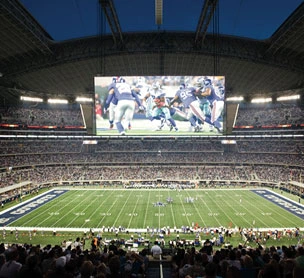Blog Details
The indoor display market will be dominated by developments in LED displays

- Posted On 29 Aug 2022
Due to their high durability, adaptability, brightness, and ease of installation, outdoor LED screen are now a common sight along roads, at athletic venues, and on the sides of buildings. LED displays are now often employed in indoor environments because to advancements in technology. The fantastic indoor LED screen experience for viewers is made possible by shrinking pixel pitch, which also enables high quality resolutions, bezel-free designs, screens in a variety of forms and sizes, and the capacity to show high brightness.

Let's talk about some of the ways indoor LED displays may dominate the indoor signage space before we go into the technical details.
updated applications
Indoor signage has shifted from being dominated by LCD panels to being dominated by LED displays.
- Merchandising display in stores
- presentations of information in public spaces
- exhibits in the conference room
- In control rooms, displays
Massive indoor digital screens up to 216 inches can be produced by LED display makers! These screens use modular construction techniques, making them simple to carry, install, and maintain in contrast to LCD signs, which require removal from the mount for maintenance and worry about the screen cracking from little bumps.
High contrast digital screens on digital displays have transformed teaching by offering a very engaging experience. LED displays offer far superior brightness compared to more conventional options like projectors without the need to reduce the lights, ensuring that everyone can see the show properly.
As a backdrop for movies and television shows, "green screens" are being replaced with LED displays in the field of video production. The LED video wall provided crucial backgrounds during the production, which also aided performers in becoming fully immersed in their characters. Additionally, changing sets took only a short amount of time.
The initial cost of these installations is high, but since you won't need to transport your complete equipment everywhere, it can easily be justified. Another thing to keep in mind when using large LED screens indoors is to maintain the air conditioning strong because the heat produced by these displays may be fairly evident and may have a detrimental impact on the user experience. However, this can also be avoided by purchasing LED displays that employ common-cathode technology, as will be described later.

Comparing common anodes and cathodes
With time, the indoor use of LED displays has advanced thanks to the LED screen industry's solutions to every problem that has previously slowed it back. The construction of the LED itself was a significant issue because each individually packaged LED has two terminals: the anode, which is connected to the positive voltage in a circuit, and the cathode, which is connected to the circuit's negative voltage. The majority of indoor LED displays use a common-anode configuration, in which all packed LED anodes are interconnected. Different voltages are needed when using different coloured LEDs. Therefore, when a common-anode design is employed, some colours receive more voltage than is necessary, resulting in energy loss and increased heat production.
By using a common-cathode architecture that joins the LED cathodes, many of these problems can be solved. Dual power supplies are employed in a common-cathode design, giving each LED only the voltage it needs. This leads to a 15–30% decrease in power consumption, which also lowers the rate of failed pixels. Additionally, the operating temperatures drop in line, minimising the heat problem related to indoor LED displays.
overcoming some lingering obstacles
Because common-cathode technology now accounts for only 10% of the indoor LED display industry and is more expensive than common-anode technology, change is likely to be gradual. The common-cathode LED supply chain is still in the early stages of development.
Although common-cathode displays' two power supplies aid in energy savings, the PCB design is complicated. Additionally, several patents are a hindrance to the visual performance of LED displays using this technology. These issues deter makers of digital signage from pursuing common-cathode technology. But given the potential for new indoor uses, common-cathode displays are probably going to become more popular.
A digital image's colour and contrast can be enhanced with the help of a technology called high dynamic range, or HDR. In HDR video footage, different exposures are used to capture each scene, which are then combined to create a single recording that produces a brighter video. Research indicates that the market for sub-1.0mm super fine pitch screens will grow to 75.53% in 2021. Vendors are attempting to raise the visual quality of common-cathode solutions and secure patents in response to the growing demand in order to overcome these difficulties and clear the way for new technology to be applied in effective indoor LED screen systems.
